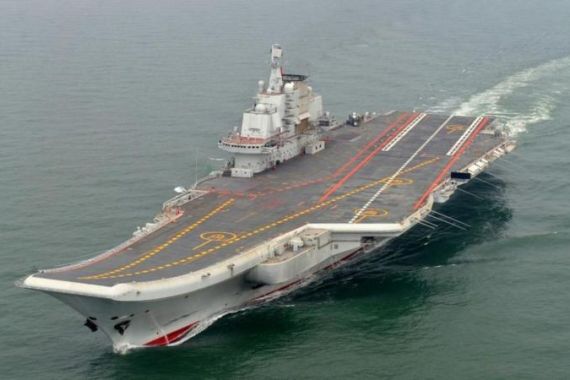China commissions first aircraft carrier
Refurbished Soviet ship seen as symbolic tour de force amid tensions with neighbouring Japan over disputed islands.

China has sent its first aircraft carrier into formal service amid a tense maritime dispute with Japan in what some are calling a show of force.
The 300-metre-long Liaoning, named after the province where it was refitted, is a refurbished Soviet ship purchased from Ukraine.
Keep reading
list of 4 itemsPalestinian Prisoner’s Day: How many are still in Israeli detention?
‘Mama we’re dying’: Only able to hear her kids in Gaza in their final days
Europe pledges to boost aid to Sudan on unwelcome war anniversary
Tuesday’s unveiling is an attempt by China to be a leading Asian naval power, although the ship is not expected to carry a full complement of planes or be ready for combat for some time.
China cast the formal handing over of the carrier to its navy, which was attended by President Hu Jintao and Premier Wen Jiabao, as a triumphant show of national strength at a time of tensions with Japan over islands claimed by both sides.
“The smooth commissioning of the first aircraft carrier has important and profound meaning for modernising our navy and for enhancing national defensive power and the country’s overall strength,” the Xinhua news agency cited Wen as saying at the commissioning ceremony in the northern port of Dalian.
Sino-Japanese relations deteriorated sharply this month after Japan bought the East China Sea islands, called Senkaku in Japan and Diaoyu in China, from their private owner, sparking anti-Japan protests across China.
‘Symbolic move’
In a sign of the tensions, China has postponed a ceremony marking the 40th anniversary of the resumption of diplomatic ties with Japan.
“China will never tolerate any bilateral actions by Japan that harm Chinese territorial sovereignty,” Vice Foreign Minister Zhang Zhijun told his Japanese counterpart on Tuesday as the two met in a bid to ease tensions
Michael Penn, the executive director of the Shingetsu News Agency in Toyko, told Al Jazeera that the risks of military confrontation between the two nations were scant.
“We’re talking about countries here on which the global economy depends … the second and third largest economies,” he said. “Full-scale war is out of the question.”
Richard Bitzinger, a military specialist at Nanyang Technological University in Singapore, told Al Jazeera that having just one carrier, which China obtained from the Ukraine in 1998, “is mostly a symbolic move”.
He said the carrier gives the world’s second largest economy “a modicum of air power”, although it might “very quickly evolve into a real fighting capability”.
He added that while it will have an impact on the region, the US currently has 11 Nimitz class carriers, six of which are based in the Pacific.
“This is more than a match for this current carrier that the Chinese have, which at the most can maybe fly about a dozen, a dozen and a half fighter jets,” he said.
Uncertain role
So far the trial runs of the aircraft carrier have been to test the ship’s propulsion, communications and navigation systems.
But launching and recovering fixed-wing aircraft at sea is a much trickier proposition.
Beijing hasn’t said what role it intends the carrier to fill other than helping safeguard China’s coastline and sea links.
The Liaoning has also been portrayed as a kind of test platform for the future development of up to five domestically built Chinese carriers.
Writing in Tuesday’s China Daily newspaper, retired Rear Admiral Yang Yi said the carrier will be used to master the technology for more advanced carriers.
He said it also will be used to train in how to operate such a craft in a battle group and with vessels from other nation’s navies.
Without specifically mentioning China’s territorial disputes, Yang acknowledged other countries’ concerns about its growing military might, but said Beijing wouldn’t shy from flexing its muscles.
“When China has a more balanced and powerful navy, the regional situation will be more stable as various forces that threaten regional peace will no longer dare to act rashly,” he wrote.